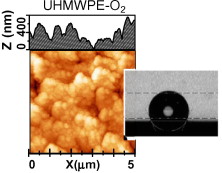A. Terriza, R. Álvarez, A. Borrás, J. Cotrino, F. Yubero, A.R. González-Elipe
Journal of Colloid and Interface Science, 376 (2012) 274–282
doi: 10.1016/j.jcis.2012.03.010

The wetting behavior of fluorocarbon materials has been studied with the aim of assessing the influence of the surface chemical composition and surface roughness on the water advancing and receding contact angles. Diamond like carbon and two fluorocarbon materials with different fluorine content have been prepared by plasma enhanced chemical vapor deposition and characterized by X-ray photoemission, Raman and FT-IR spectroscopies. Very rough surfaces have been obtained by deposition of thin films of these materials on polymer substrates previously subjected to plasma etching to increase their roughness. A direct correlation has been found between roughness and water contact angles while a superhydrophobic behavior (i.e., water contact angles higher than 150° and relatively low adhesion energy) was found for the films with the highest fluorine content deposited on very rough substrates. A critical evaluation of the methods currently used to assess the roughness of these surfaces by atomic force microscopy (AFM) has evidenced that calculated RMS roughness values and actual surface areas are quite dependent on both the scale of observation and image resolution. A critical discussion is carried out about the application of the Wenzel model to account for the wetting behavior of this type of surfaces.

